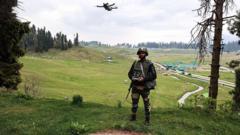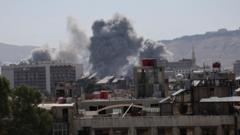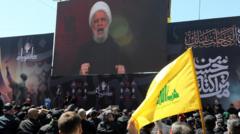The use of drones in recent military confrontations between India and Pakistan signifies a critical shift in the dynamics of their conflict, raising alarms internationally as both nations navigate the complexities of modern warfare.
Emerging Drone Warfare Signals New Tensions in India-Pakistan Relations

Emerging Drone Warfare Signals New Tensions in India-Pakistan Relations
The India-Pakistan conflict has escalated into drone warfare, as both nations exchange unmanned aerial strikes, marking a dangerous evolution in their long-standing rivalry.
The first drone war between nuclear-armed rivals India and Pakistan has marked a significant escalation in their long-standing conflict. On Thursday, India accused Pakistan of launching a series of drone and missile attacks targeting military installations within Indian-controlled Kashmir, a claim Islamabad rejected. Pakistan, in turn, asserted that it successfully intercepted 25 Indian drones in recent confrontations. Experts warn that this tit-for-tat exchange presents a precarious new phase, as unmanned aerial vehicles replace conventional artillery in hostilities, magnifying risks along a volatile border.
"The Indo-Pak conflict is transitioning into a drone era, where precision and invisibility may dictate responses,” noted Jahara Matisek, a professor at the US Naval War College. As global powers call for restraint, the valley where both nations operate contains drones that can provide real-time surveillance and strategic advantage, reshaping the nature of conflict.
The situation has intensified since Pakistani airstrikes reportedly resulted in the deaths of over three dozen individuals, while India confirmed civilian casualties from shelling. The back-and-forth accusations include India's claims of retaliatory strikes following a militant attack on tourists, which Pakistan disclaims involvement in. Islamabad's military has also claimed interceptions of Indian unmanned aircraft using advanced countermeasures, highlighting a growing reliance on drone technology for defense.
Modern drones enhance military capabilities by serving dual purposes such as enemy-targeting and suppressing air defenses. Countries like India, bolstered by contracts for advanced drones like the US-made MQ-9B Predator, are developing sophisticated airstrike capabilities.
Pakistan also boasts a diverse drone fleet of indigenous and imported systems, solidifying its military standing with a robust arsenal that includes various operational drones from global partners, including China and Turkey. Both countries are actively incorporating unmanned systems as strategic assets, marking an ongoing arms race.
Despite similarities to drone operations in Ukraine, experts believe the current scope of such warfare in India-Pakistan remains restricted, serving tactical responses rather than paving the way for comprehensive retaliatory strategies. Manoj Joshi, an Indian defense analyst, warns that current drone exchanges might only herald the beginning stages of broader conflict.
As both sides continue to escalate drone usage, the potential for unintended consequences grows. "Drones lower the threshold for military action, but they also spark new escalation dynamics," cautioned Professor Matisek, emphasizing the delicate balance between military innovation and the risks involved between two nuclear powers. The future trajectory remains uncertain, raising pivotal questions about conflict escalation in the region.
"The Indo-Pak conflict is transitioning into a drone era, where precision and invisibility may dictate responses,” noted Jahara Matisek, a professor at the US Naval War College. As global powers call for restraint, the valley where both nations operate contains drones that can provide real-time surveillance and strategic advantage, reshaping the nature of conflict.
The situation has intensified since Pakistani airstrikes reportedly resulted in the deaths of over three dozen individuals, while India confirmed civilian casualties from shelling. The back-and-forth accusations include India's claims of retaliatory strikes following a militant attack on tourists, which Pakistan disclaims involvement in. Islamabad's military has also claimed interceptions of Indian unmanned aircraft using advanced countermeasures, highlighting a growing reliance on drone technology for defense.
Modern drones enhance military capabilities by serving dual purposes such as enemy-targeting and suppressing air defenses. Countries like India, bolstered by contracts for advanced drones like the US-made MQ-9B Predator, are developing sophisticated airstrike capabilities.
Pakistan also boasts a diverse drone fleet of indigenous and imported systems, solidifying its military standing with a robust arsenal that includes various operational drones from global partners, including China and Turkey. Both countries are actively incorporating unmanned systems as strategic assets, marking an ongoing arms race.
Despite similarities to drone operations in Ukraine, experts believe the current scope of such warfare in India-Pakistan remains restricted, serving tactical responses rather than paving the way for comprehensive retaliatory strategies. Manoj Joshi, an Indian defense analyst, warns that current drone exchanges might only herald the beginning stages of broader conflict.
As both sides continue to escalate drone usage, the potential for unintended consequences grows. "Drones lower the threshold for military action, but they also spark new escalation dynamics," cautioned Professor Matisek, emphasizing the delicate balance between military innovation and the risks involved between two nuclear powers. The future trajectory remains uncertain, raising pivotal questions about conflict escalation in the region.





















